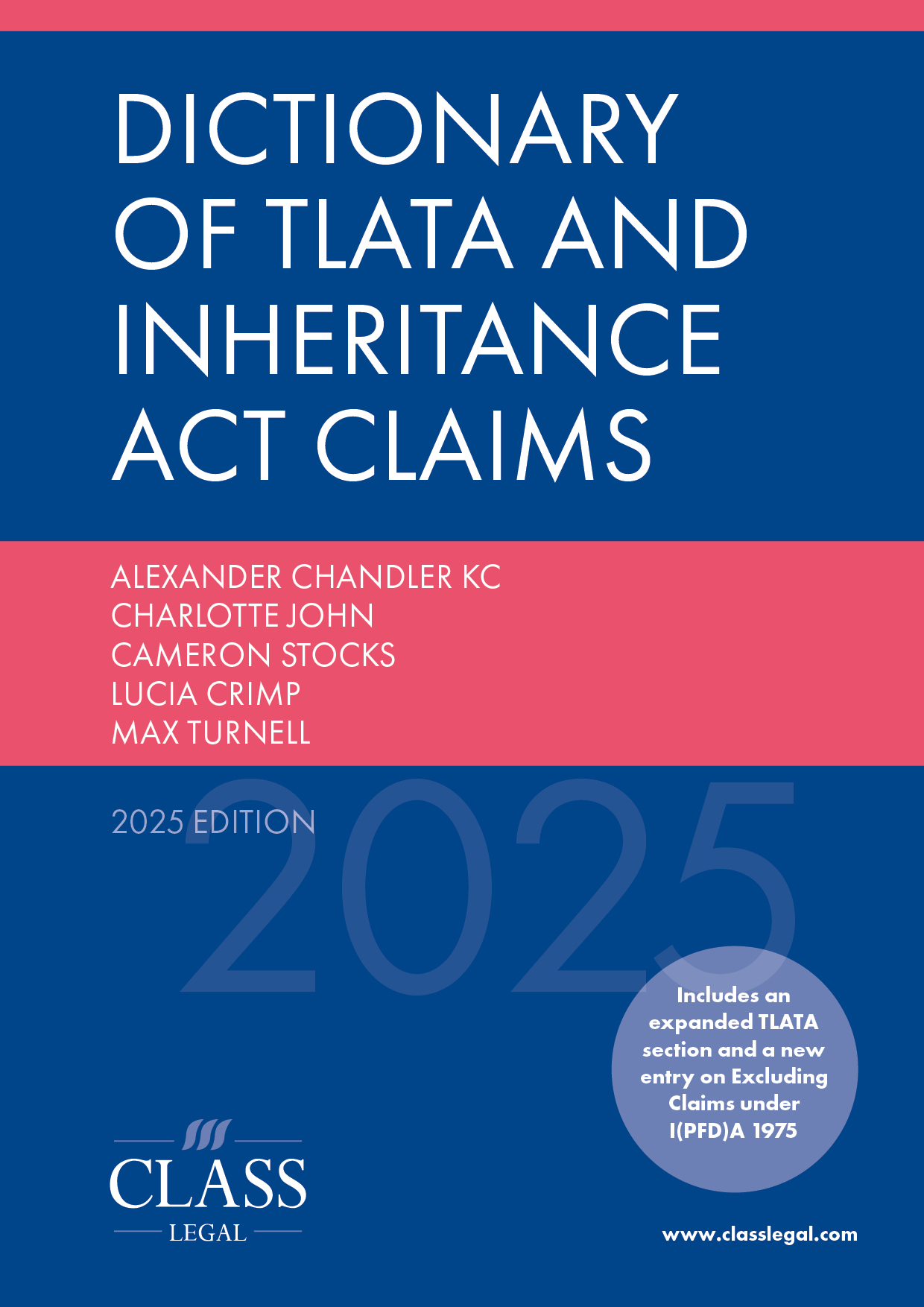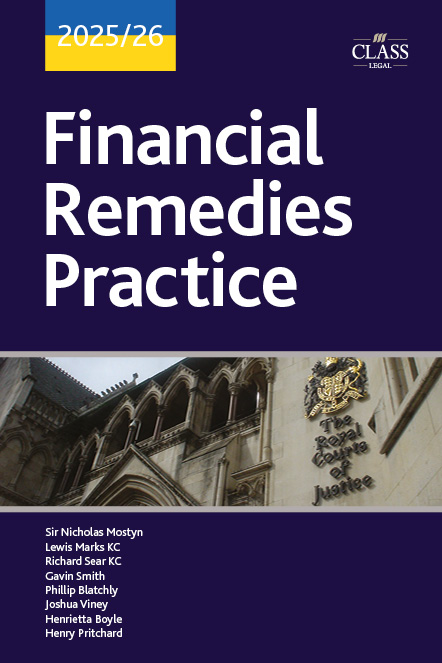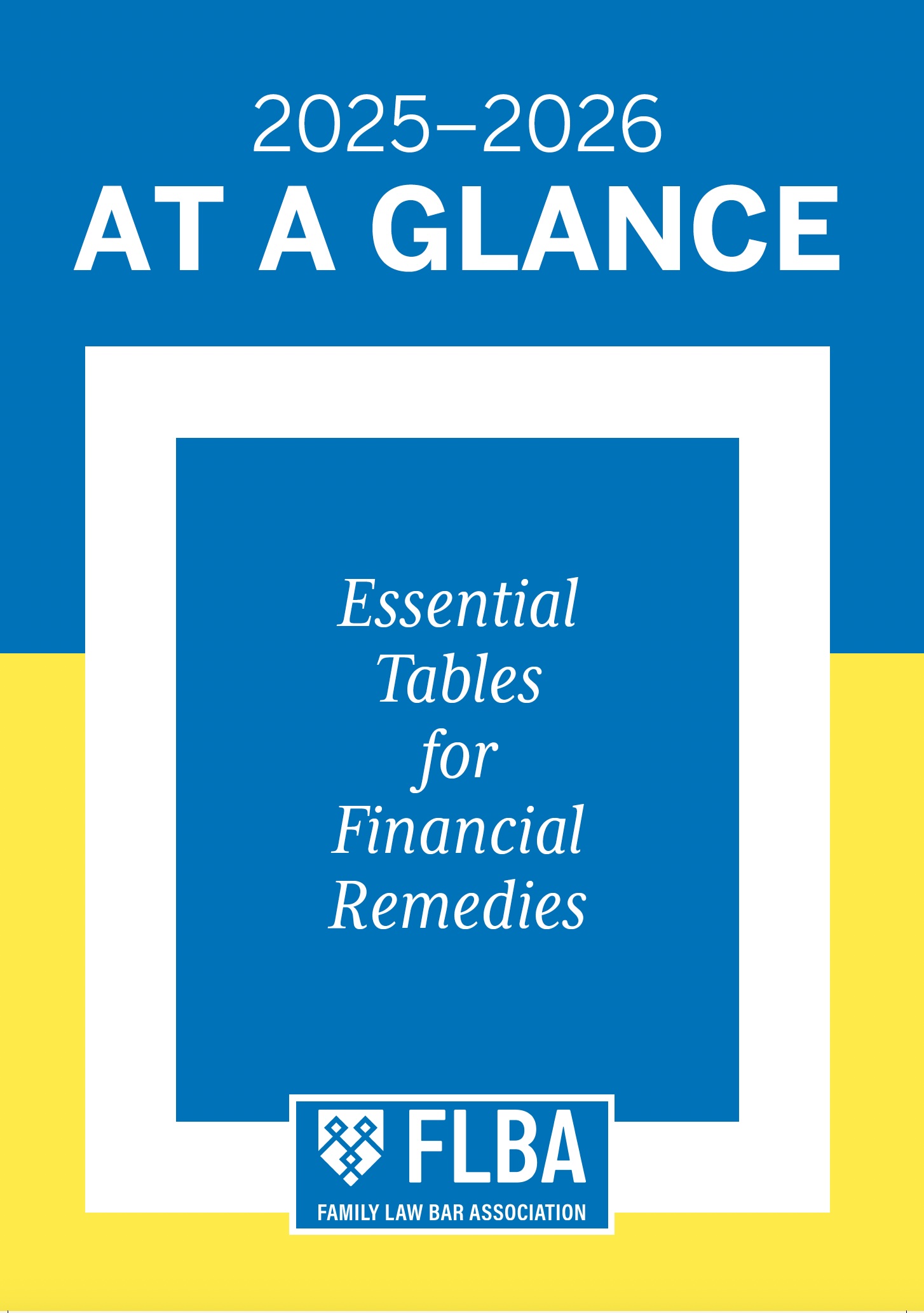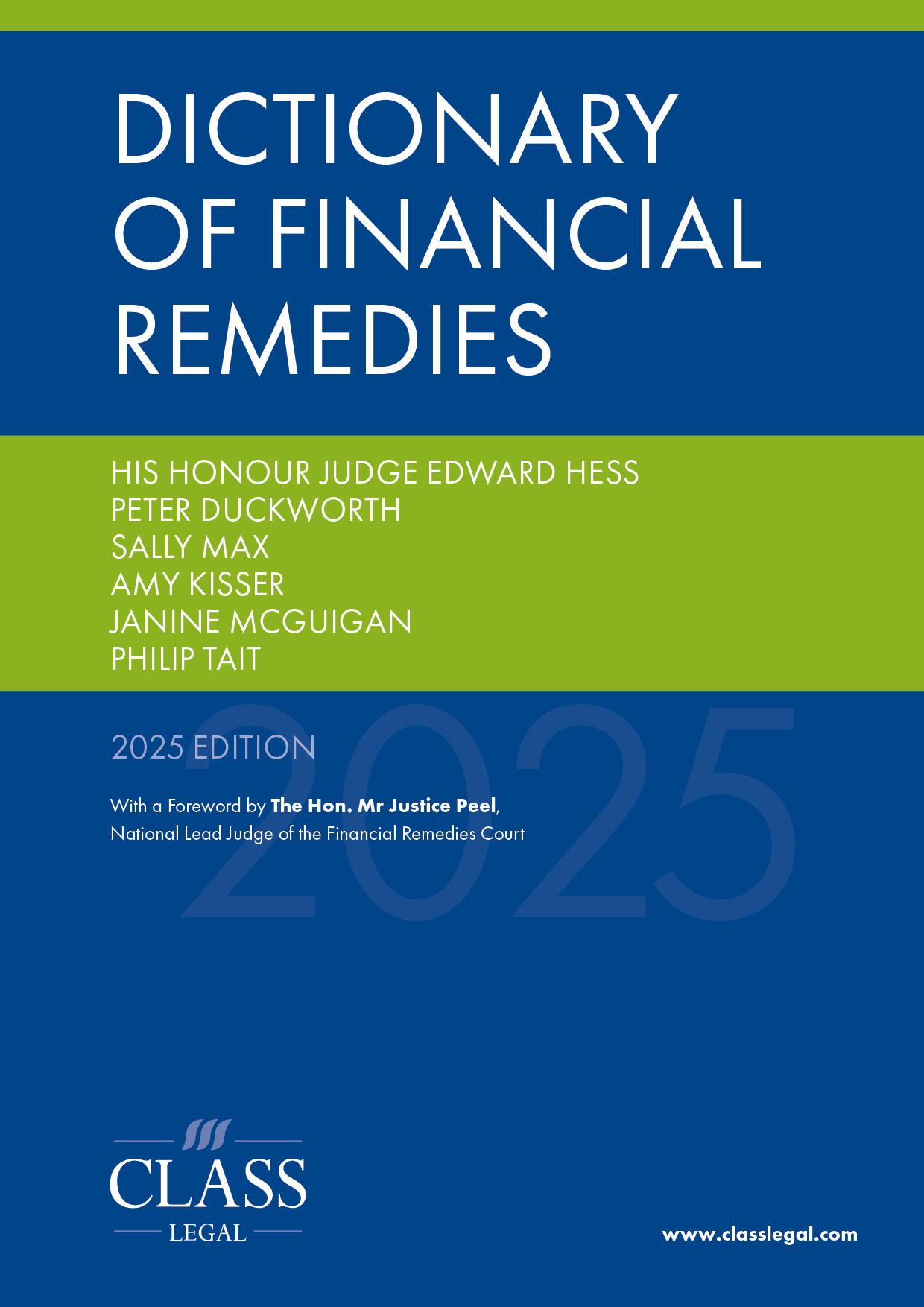
Principles vs Resources: Conduct and the Law Commission Scoping Report
Published: 18/03/2025 06:00

The Law Commission’s long awaited scoping report1 on financial remedies was published on 18 December 2024. It concludes that the law relating to financial remedy should be reformed. We asked the Law Commission to clarify whether their concerns in respect of the fairness of the outcomes was restricted to litigants who had experienced domestic abuse in their marriage. The Law Commission subsequently confirmed their ‘criticism of lack of fairness in outcomes is not confined to conduct … The operation of the conduct provisions (which is the only s25 factor we were specifically directed to look at) means there is an additional source of potential unfairness for victim-survivors of domestic abuse, which other divorcing individuals are less likely to experience’.2
The Law Commission’s report follows the conclusion in the Resolution report ‘that the current approach of the courts to s25(2)(g) of the Matrimonial Causes Act 1973 i.e. conduct leads to unfair outcomes for some victim-survivors of domestic abuse’.3 That was followed by the Fair Shares analysis which concluded that ‘a question can be raised as to the extent to which the strict position in relation to the lack of express consideration of domestic abuse remains appropriate, given that the overall picture demonstrated in this report is one of relative financial disadvantage for female survivors of domestic abuse during marriage and in the years following divorce compared with other female divorcees. Not only do female domestic abuse survivors exit marriage with a range of financial vulnerabilities, but these financial disadvantages continue into the longer-term’.4
The Law Commission also found that the law around conduct needs to be more certain, and that it would be beneficial for the law to state clearly: (1) what forms of behaviour will be considered conduct (whether that be personal misconduct or litigation misconduct); and (2) the impact that this will or may have on a claim for financial remedies.
This criticism echoes Resolution’s conclusion that:
‘Currently, litigants and lawyers are not clear about what domestic abuse would cross the threshold of inequitable to disregard, and how to quantify the impact if it does cross the threshold. There have been references to the need for clarification and guidance since S v S (Non-Matrimonial Property: Conduct)5 and K v L.6 This has hitherto been resisted to allow the court wide discretion, but this discretion is now creating uncertainty’.
This call for clarification is reinforced in the Fair Shares report.
In this article we consider how the law could be fairer and more certain pending statutory reform.
Principles vs resources
The Law Commission’s consultation gave rise to two dominant themes when it came to domestic abuse as conduct in financial remedy proceedings.7
The first was the view expressed by those ‘who considered that there should be a greater recognition of domestic abuse as conduct, whether by defining conduct (for example in an amended section 25(2)(g)) as specifically including domestic abuse, or otherwise’. The authors of this article suggest that the majority of stakeholders adopting that position are likely to be practitioners and, in particular, solicitors. It reflects the majority view of respondents to the Resolution survey, by far the largest category of which were solicitors (57.4%). This is hardly surprising; solicitors working at the coal face of family law observe at close quarters the impact of domestic abuse on their clients before, during and after proceedings.
The alternative view was that the Law Commission found almost all members of the judiciary they spoke to were opposed to greater recognition of conduct in financial remedies cases. The report explains that those who do not agree with reform are primarily concerned ‘with the practical problems this would raise in terms of stretched court resources, delays, costs, increased animosity between the parties and reduced chance of settlement’.8 Put another way, the judiciary are concerned about the impact to justice for the many, if they spend more time dispensing justice to the few. Again, this is not surprising. The consequences of a routinely under-resourced justice system, including staff shortages and fewer judicial sitting days, are creating unhappy delays to justice. Our judges do not want there to be a shift in the law if they believe (rightly or wrongly) that such a shift would increase pressure on the family justice system further.
Thus, the tension between finding fairness for the litigants in one case, at the cost of the availability of resources for others, appears now to be the biggest determinant of the quality of justice in financial remedy cases involving domestic abuse.
Resources
The delays in private law children’s cases are usually cited as a cautionary tale. The argument goes that the culture shift in the way in which domestic abuse is dealt with in private law cases has led to a big expansion of finding of fact hearings that threaten to overrun the system. The fear is that if we allow for greater consideration of domestic abuse in financial remedy cases, the system will become overwhelmed. The authors of this article disagree with that position for a number of reasons as set out below.
First, it is respectfully suggested that there is at present insufficient data to properly evaluate the ‘floodgates’ argument. Further, the data that does exist does not support the floodgates claims. There are varying figures in the research, but there is consensus that more than 50% of private law cases involve allegations of domestic abuse. Despite that, most cases are still resolved by consent.
Secondly, as set out above, despite the consensus that over 50% of private law cases involve allegations of domestic abuse, it is worth noting that only a small percentage of private law cases require a separate fact-finding hearing. Professor Rosemary Hunter KC kindly directed us to some of the latest research:
- Domestic abuse and private law children cases: A literature review (MoJ, 2020) – Adrienne Barnett found the research to 2020 indicated that fact-finding hearings were held in fewer than 10% of private law children cases.9
- ‘The gap between facts and norms: contact, harm and futility’10 – Kieran Walsh examined the claim that fact-finding hearings are said to be a rarity. He conducted a case file analysis of 102 cases with a ‘risk of harm’ flag, across three courts (72% of which included allegations of domestic abuse). Out of those 102 cases only one had a completed fact-finding hearing, with one other being scheduled but not yet held and two others having had fact-finds in earlier linked proceedings (p 38). Walsh concluded that ‘fact-findings can be said to have been ordered in 3.9 percent of cases encountered in this sample group but were only completed in 0.9 percent of all cases. Fact-findings were, indeed, rarer than gold dust’.
Thirdly, whilst we understand that the comparison with finding of fact hearings in private law hearings may seem a natural one to draw, it works on the assumption that, in most cases in which domestic abuse is alleged as a feature of conduct, a preliminary fact finding hearing would be required. However, the most common purpose of a preliminary fact finding hearing in a financial remedy case is to establish third party interests which have a direct impact on computation. The sorts of findings necessary in a contested case to inform judicial discretion in terms of distribution (sharing, needs, compensation, etc) will ordinarily be considered at the final hearing.
Fourthly, the Fair Shares research tells us that whilst victim-survivors are less likely to achieve any kind of settlement in relation to their finances, if they do find themselves parties to financial remedy proceedings, they are far more likely to need a judge to determine the outcome – 17% of financial remedy cases involving domestic abuse will ultimately have their claims determined by a judge, compared to only 4% of financial remedy cases that do not involve domestic abuse.11 Therefore victim-survivors are far more likely to end up in a final hearing (often for reasons beyond their control) in any event: why should they not be permitted to raise conduct as a feature when they do? They are in a lose/lose situation: they are forced to a final hearing due to ongoing abuse but are then prevented from giving evidence to the judge about the abuse they have suffered.
Whilst it is imperative that we find ways to reduce burdens on the court and the consequent delays to justice,12 it is hard to reconcile the figures and observations above with the claim that any change to the current approach to conduct in financial remedies cases will ‘open the floodgates’.
Principle
The Fair Shares research provides a clear evidential picture of the financial outcomes for victim-survivors and the difficulties they face in reaching a fair settlement, or indeed any settlement, where an abusive dynamic exists. The picture painted is one of relative financial disadvantage for female survivors of domestic abuse at the end of their marriage:
- Although female domestic abuse survivors were less likely than other women to make financial arrangements, they were more likely to require the use of lawyers.11
- Female domestic abuse survivors were more likely (70% compared to 63%) than other women to have incurred legal and mediation costs in attempting to reach a financial arrangement. Despite this, only 4% of arrangements made by female survivors had been made via mediation compared to one in five (19%) of arrangements made by other women.14
- Female domestic abuse survivors with dependent children were more likely to have their children living with them than other mothers (89% compared to 74%) at the time of divorce, and their children had less contact with their other parent (e.g. 21% reported that their children never saw the other parent, compared to 6% of other mothers).15
- Up to 5 years after their divorce, female domestic abuse survivors continued to be more likely than other women to be in financially precarious situations.16
Thus, victim-survivors are more likely to have children in their care, have spent more on mediation and legal fees, and be more financially vulnerable, both at the time of divorce and 5 years on. If the aim is to give both parties an equal start on the road to independent living, this is a bleak picture indeed.
Certainty – definition of conduct
The Law Commission reported that a ‘definition of conduct, or guidance on what would be considered conduct, would be helpful for divorcing individuals’.17 Given the number of litigants in the system without legal representation, greater clarity is now essential.
Parliament has already provided the legal definition of domestic abuse in the Domestic Abuse Act 2021.18 Offences commonly committed during abusive marriages include, but are not limited to, assault, sexual assault, rape, harassment, coercive and controlling behaviour, stalking, making threats to kill, theft and criminal damage: all conduct which, if found to have happened by a criminal court, would lead to a conviction.
The Law Commission reported that ‘a representative of a civil society organisation primarily representing men stated that an allegation of domestic abuse should only be considered as conduct by the financial remedies court where there has been a criminal conviction for that abuse’ .19 Given the very low conviction rates,20 and the higher burden of proof required in the criminal court, it is plain that a domestic abuse related conviction cannot be the test for whether the alleged domestic abuse crosses the threshold into s 25(2)(g) conduct. However, at present, the fact of a conviction may make no difference at all. A judge in financial remedy proceedings is highly likely to rule that domestic abuse which crosses the threshold of criminal behaviour, even where there is a conviction, is excluded either because it is not exceptional, or is not relevant because an adverse financial consequence of the abuse cannot be proved.
Using the criminal statutory definitions as a point of reference when determining what crosses the line for conduct that is inequitable to disregard would provide clarity and accessibility for judges and litigants alike. Such an approach would not only ensure that the family justice system reflects public opinion and government views on what is serious misconduct, but it would also generate consistency within the Financial Remedies Court, and between the Financial Remedies Court and the different limbs of the justice system.
It would also alleviate an issue identified by the Law Commission, that ‘the frequency with which judges deal with allegations of domestic abuse may result in abusive behaviour being less likely to cause a “gasp” than it otherwise might’.21 The clear implication is that serious domestic abuse which, if found in the criminal court would lead to a conviction and possibly even pass the custody threshold, is such a common feature in family cases that judges have become immune to it and, by extension, too dismissive of it. We would respectfully suggest that there is some support for this in the use of language adopted when dealing with such cases. To refer to an abusive marriage as an ‘unhappy’ one, referring to raising domestic abuse as ‘rummaging through the attic’, or to refer to the relationship between an abuser and victim-survivor as ‘acrimonious’ minimises victim-survivors’ experiences. It gives the impression that these issues are insufficiently serious to warrant proper reflection in the overall award.
Given the strides towards greater transparency in the Financial Remedies Court, it will be interesting to see what the press and the public will think of judges telling (usually) wives whose husbands have been convicted of domestic abuse, or have committed acts which would pass the threshold of conviction, that such abuse is not considered sufficiently exceptional to be taken into account when it comes to dividing their finances.
Certainty – quantification
The principled argument against allowing domestic abuse to be taken into account in financial remedy cases is that there is no clear way to quantify the impact of that conduct, especially in a sharing case.
Judges have reached different conclusions about quantification:
- Al-Khatib v Masry:22 Munby J (as he then was) seemed to accept the proposition that conduct could drive him to ‘the very top end of the applicable discretionary bracket applicable to the case’;
- H v H (Financial Relief: Attempted Murder as Conduct):23 Coleridge J identified that ‘the court should not be punitive or confiscatory for its own sake’ but that the conduct is ‘a potentially magnifying factor when considering the wife’s position under the other subsections and criteria. It is the glass through which the other factors are considered’;
- FRB v DCA (No 2):24 Cohen J set off wife’s conduct (not informing H that in fact he was not the father of their child) against H’s non-disclosure: ‘I am quite confident that he has access to/ownership of assets which he has not disclosed as well as his interest in Company V (in particular) which I cannot quantify. I consider in the circumstances that whilst I cannot and should not try to put a monetary figure on undisclosed assets, I should likewise not reduce W’s award by giving her a lower percentage of the disclosed assets’. Interestingly, therefore, only the husband in that case knows the size of the penalty paid by wife;
- Goddard-Watts v Goddard-Watts:25 Macur LJ: ‘I take the view that the husband’s fraud is “conduct” for the purpose of subsection 2(g) in that it provides “the glass” through which to address the unnecessary delay in achieving finality of the wife’s overall claim, including her unanticipated contribution to the welfare of the family post 2010’.
If, as is suggested, personal misconduct is capable of aggravating claims based on the other s 25(2) subsections, this undermines the current legal position: that domestic abuse, if it can be quantified at all, must be quantified only with reference to the causal needs it generates.
The Law Commission noted:
‘One stakeholder suggested that, rather than taking its current approach to conduct focusing on the impact on the victim-survivor (for example, assessing their ability to earn), the court should deal with conduct on a compensatory basis. This would avoid placing pressure on the victim-survivor to have reacted in a particular way to the abuse. Where extreme bad behaviour had occurred in a short marriage but had not affected earning capacity, meaning that the victim-survivor would receive nothing using the current treatment of conduct, a compensatory payment could be appropriate.’26
Might the answer be to reflect s 25(2)(g) conduct as a species of compensation?
In Miller/McFarlane,27 Baroness Hale said:
‘A second rationale, which is closely related to need, is compensation for relationship-generated disadvantage. Indeed, some consider the provision for need is compensation for relationship-generated disadvantage. But the economic disadvantage generated by the relationship may go beyond need, however generously interpreted.’
The few compensation cases following Miller/McFarlane have, typically, focussed on the claims of wives who sacrificed a lucrative career, allowing room for her spouse’s career to flourish whilst she focussed on the children and domestic matters.
Taking two successful claims as examples, in RC v JC28and TM v KM,29 Moor J and HHJ Hess, respectively, took the view that by giving up a well-paid job for the benefit of the family, as a matter of logic, the wife had suffered relationship-generated disadvantage which, in those cases, required compensation over and above any award that might be made in her favour on the basis of need alone. The quantification of the compensation due was highly discretionary and broad brush, acknowledging the impossibility in such cases of identifying with any precision the actual loss a wife in those circumstances might be said to have suffered.
There are, arguably, parallels between these types of compensation cases and conduct cases involving domestic abuse. Once the fact of domestic abuse has been established, the research could not be clearer: a victim-survivor almost certainly will suffer disadvantage as a result of the domestic abuse, in a myriad of ways, both measurable and immeasurable, at the time of the divorce and for years beyond. Just as in the typical compensation case, it is likely to be an impossible task to identify with any precision the actual loss a wife in those circumstances might have suffered. Yet the victim-survivor’s claims are bound by needs, without the discretionary top up afforded to wives who succeed in a typical compensation claim.
The unfairness of that distinction is compounded by the fact that some spouses who give up high-earning careers may have been ‘active enthusiastic voluntary participant[s] in the events that give rise to the claim’.30 Whilst that may be a generalisation, the wives in the cited authorities presumably had some agency in the decision to give up work. In contrast, most victim-survivors of domestic abuse have no agency at all.
A similarly broad brush, compensation-based approach may well lead to a fairer approach for victim-survivors. The abuse could be reflected by a standalone award, unconnected to need. This would resolve the question of whether conduct is relevant in sharing cases and would reflect what Lord Nichols said in Miller/McFarlane, that ‘Compensation and financial needs often overlap in practice, so double-counting has to be avoided. But they are distinct concepts, and they are far from co-terminous’.
An alternative approach to quantification might be drawn from the Australian model which assesses the impact of domestic abuse in terms of contributions: the victim-survivor’s share of the assets is enhanced to take account of the fact their contributions were made ‘significantly more arduous than they ought to have been’31 as a result of the domestic abuse. This line of jurisprudence has now been recognised in statute in Australia with the passing of the Family Law Amendment (No 2) Act 2024, which received Royal Assent on 10 December 2024. Relevant for these purposes are the amendments to the definition of ‘family violence’ (clear parallels with the Domestic Abuse Act 2021) and the amendments to s 79(4)(c) and s 90SM(4)(c) Family Law Act 1975: family violence considerations relating to contributions.32
Conclusion
All professionals working in family justice will understand and share the expressed concerns that any changes to the court’s approach to domestic abuse might increase delays and put further pressure on resources. We all see the impact of those delays on our clients, and it is only right that the potential negative impact of any change to the law, practice or procedure on the issue of conduct must be weighed in the balance.
However, as Mostyn J has said ‘the law … is not moribund but must move to reflect changing social values’.33 Our ‘awareness of the incidence of domestic abuse, and its harmful and pernicious effects’34 is steadily increasing. In the absence of statutory reform, it is respectfully suggested by the authors of this article that the Financial Remedies Court must now shift its approach to properly reflect those harmful and pernicious effects in court processes and awards which are fairer to victim-survivors.
There is scope within the existing statutory framework to adopt a ‘compensation’ or ‘contributions’ approach to court-led awards in conduct cases and to apply those concepts with equal force whether it is a needs or a sharing case.
The court would need to recognise – perhaps to even elevate into a presumption – that domestic abuse gives rise in almost every case to financial and social costs which will be felt by the victim-survivor and their children many years after the relationship has ended. Further, that it is impossible to measure those costs with any precision in the vast majority of cases. That would not be an unreasonable position to adopt bearing in mind the conclusions of the Fair Shares report.
It is acknowledged that recognising domestic abuse via compensation or contributions models in the ways set out above would mean the court adopting a broad brush to assess the additional award a victim-survivor should receive. However, the court is well versed in taking a broad brush approach where necessary. For example, when determining the extent to which a ‘mingled’ asset retains its non-matrimonial nature for the purpose of (not) sharing, a judge will often stand back and make an adjustment which feels ‘fair’ in all the circumstances.35
Similarly, it would be open to the court to consider if it is fair for a victim-survivor to receive an award which is greater – perhaps 5% or 10% greater – than they would otherwise receive on a strict application of the needs or sharing principles. That is the approach which has been adopted in the more traditional compensation cases and, whilst there is judicial inconsistency in the application of the compensation principle, it remains one of the three strands of distribution identified by the House of Lords in Miller/McFarlane.
Would adopting such an approach lead to delays, costs, increased animosity between the parties and reduced chance of settlement? It may do in the short term, but not necessarily. Once the law is settled, that is the basis on which parties will resolve their cases. Abusers who drive cases to a final hearing in an attempt to avoid an increased award to their victim-survivor spouse will be penalised in costs.
On the 31 January 2025, the National Audit Office released its report into Tackling violence against women and girls.36 It calculated that the annual economic and social cost of domestic abuse is £84 billion. In the absence of statutory reform, the Financial Remedies Court could, perfectly properly and in line with established jurisprudence, ensure that: (1) abusers take on some of the financial responsibility for the damage they cause; and (2) victim-survivors are given extra resources to ameliorate the disadvantage they will continue to suffer long after the marriage has ended.










